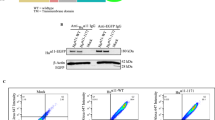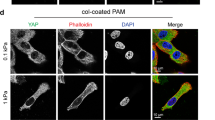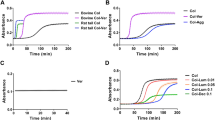Abstract
Matrix remodeling, degradation, inflammation and invasion liberate peptide fragments that can subsequently interact with cells in an attachment-independent manner. Such ‘soluble’ matrix components, including collagens, fibronectin and laminin, induced Smad activation (termed crosstalk signaling), which follows a similar chronological sequence and R-Smad specificity as induced by transforming growth factor (TGF)-β1. Smad4 nuclear translocation occurred in response to collagen binding, indicating downstream signal propagation. TGF-β scavenging antibody affected only TGF-β1, but not crosstalk-induced responses. TGF-β type II receptor mutation (DR26Δ25), which is deficient in TGF-β type I receptor recruitment to the ligand, induced a heterotetramer signaling complex, and propagated Smad2 activation only through collagen induction and not TGF-β signaling. Consequentially, TGF-β ligand participation is not required for crosstalk signaling. This signaling requires a functional integrin β1 receptor as showed by RNA interference. Co-immunoprecipitation (co-IP) and fluorescent microscopy indicate the involvement of focal adhesion kinase (FAK) and Src activity in collagen-induced signal propagation, and suggest a membrane signaling complex formation that includes both TGF-β receptors and integrins. The related gene expressional responses are distinct from that evoked by TGF-β1, supporting its separate function. This signaling mechanism expands and partially explains TGF-β receptor dynamics and consequential signaling diversity-related gene expressional plasticity.
This is a preview of subscription content, access via your institution
Access options
Subscribe to this journal
Receive 50 print issues and online access
$259.00 per year
only $5.18 per issue
Buy this article
- Purchase on Springer Link
- Instant access to full article PDF
Prices may be subject to local taxes which are calculated during checkout







Similar content being viewed by others
References
Attisano L, Wrana JL . (2002). Signal transduction by the TGF-beta superfamily. Science 296: 1646–1647.
Benya PD, Padilla SR, Nimni ME . (1978). Independent regulation of collagen types by chondrocytes during the loss of differentiated function in culture. Cell 15: 1313–1321.
Benya PD, Shaffer JD . (1982). Dedifferentiated chondrocytes reexpress the differentiated collagen phenotype when cultured in agarose gels. Cell 30: 215–224.
Boyd FT, Massague J . (1989). Transforming growth factor-beta inhibition of epithelial cell proliferation linked to the expression of a 53-kDa membrane receptor. J Biol Chem 264: 2272–2278.
Chen YG, Hata A, Lo RS, Wotton D, Shi Y, Pavletich N et al. (1998). Determinants of specificity in TGF-beta signal transduction. Genes Dev 12: 2144–2152.
Comoglio PM, Boccaccio C, Trusolino L . (2003). Interactions between growth factor receptors and adhesion molecules: breaking the rules. Curr Opin Cell Biol 15: 565–571.
Derynck R, Zhang YE . (2003). Smad-dependent and Smad-independent pathways in TGF-beta family signalling. Nature 425: 577–584.
Di Guglielmo GM, Le Roy C, Goodfellow AF, Wrana JL . (2003). Distinct endocytic pathways regulate TGF-beta receptor signalling and turnover. Nat Cell Biol 5: 410–421.
Dumont N, Arteaga CL . (2002). The tumor microenvironment: a potential arbitrator of the tumor suppressive and promoting actions of TGFbeta. Differentiation 70: 574–582.
Evans JG, Matsudaira P . (2006). Structure and dynamics of macrophage podosomes. Eur J Cell Biol 85: 145–149.
Feng XH, Derynck R . (2005). Specificity and versatility in tgf-beta signaling through Smads. Annu Rev Cell Dev Biol 21: 659–693.
Franz CM, Muller DJ . (2005). Analyzing focal adhesion structure by atomic force microscopy. J Cell Sci 118: 5315–5323.
Galera P, Redini F, Vivien D, Bonaventure J, Penfornis H, Loyau G et al. (1992). Effect of transforming growth factor-beta 1 (TGF-beta 1) on matrix synthesis by monolayer cultures of rabbit articular chondrocytes during the dedifferentiation process. Exp Cell Res 200: 379–392.
Garamszegi N, Dore Jr JJ, Penheiter SG, Edens M, Yao D, Leof EB . (2001). Transforming growth factor beta receptor signaling and endocytosis are linked through a COOH terminal activation motif in the type I receptor. Mol Biol Cell 12: 2881–2893.
Gonzales M, Weksler B, Tsuruta D, Goldman RD, Yoon KJ, Hopkinson SB et al. (2001). Structure and function of a vimentin-associated matrix adhesion in endothelial cells. Mol Biol Cell 12: 85–100.
Groppe J, Hinck CS, Samavarchi-Tehrani P, Zubieta C, Schuermann JP, Taylor AB et al. (2008). Cooperative assembly of TGF-beta superfamily signaling complexes is mediated by two disparate mechanisms and distinct modes of receptor binding. Mol Cell 29: 157–168.
Gupta GP, Nguyen DX, Chiang AC, Bos PD, Kim JY, Nadal C et al. (2007). Mediators of vascular remodelling co-opted for sequential steps in lung metastasis. Nature 446: 765–770.
Hill DJ, Logan A . (1992). Peptide growth factors and their interactions during chondrogenesis. Prog Growth Factor Res 4: 45–68.
Hoodless PA, Wrana JL . (1998). Mechanism and function of signaling by the TGF beta superfamily. Curr Top Microbiol Immunol 228: 235–272.
Huse M, Chen YG, Massague J, Kuriyan J . (1999). Crystal structure of the cytoplasmic domain of the type I TGF beta receptor in complex with FKBP12. Cell 96: 425–436.
Huse M, Muir TW, Xu L, Chen YG, Kuriyan J, Massague J . (2001). The TGF beta receptor activation process: an inhibitor- to substrate-binding switch.[see comment]. Mol Cell 8: 671–682.
Jones J, Sugiyama M, Speight PM, Watt FM . (1996). Restoration of alpha v beta 5 integrin expression in neoplastic keratinocytes results in increased capacity for terminal differentiation and suppression of anchorage-independent growth. Oncogene 12: 119–126.
Kracklauer MP, Schmidt C, Sclabas GM . (2003). TGFbeta1 signaling via alphaVbeta6 integrin.[retraction in Schmidt C. Mol Cancer 2004 Jan 14;3:2; PMID: 14723796]. Mol Cancer 2: 28.
Laiho M, Keski-Oja J . (1992). Transforming growth factors-beta as regulators of cellular growth and phenotype. Crit Rev Oncog 3: 1–26.
Laiho M, Weis FM, Boyd FT, Ignotz RA, Massague J . (1991). Responsiveness to transforming growth factor-beta (TGF-beta) restored by genetic complementation between cells defective in TGF-beta receptors I and II. J Biol Chem 266: 9108–9112.
Laiho M, Weis MB, Massague J . (1990). Concomitant loss of transforming growth factor (TGF)-beta receptor types I and II in TGF-beta-resistant cell mutants implicates both receptor types in signal transduction. J Biol Chem 265: 18518–18524.
Lee MS, Kim TY, Kim YB, Lee SY, Ko SG, Jong HS et al. (2005). The signaling network of transforming growth factor beta1, protein kinase Cdelta, and integrin underlies the spreading and invasiveness of gastric carcinoma cells. Mol Cell Biol 25: 6921–6936.
Madan R, Smolkin MB, Cocker R, Fayyad R, Oktay MH . (2006). Focal adhesion proteins as markers of malignant transformation and prognostic indicators in breast carcinoma. Hum Pathol 37: 9–15.
Massague J . (2000). How cells read TGF-beta signals. Nat Rev Mol Cell Biol 1: 169–178.
Moustakas A, Heldin CH . (2005). Non-Smad TGF-beta signals. J Cell Sci 118: 3573–3584.
Mu D, Cambier S, Fjellbirkeland L, Baron JL, Munger JS, Kawakatsu H et al. (2002). The integrin alpha(v)beta8 mediates epithelial homeostasis through MT1-MMP-dependent activation of TGF-beta1. J Cell Biol 157: 493–507.
Munger JS, Huang X, Kawakatsu H, Griffiths MJ, Dalton SL, Wu J et al. (1999). The integrin alpha v beta 6 binds and activates latent TGF beta 1: a mechanism for regulating pulmonary inflammation and fibrosis. Cell 96: 319–328.
Parsons JT, Schaller MD, Hildebrand J, Leu TH, Richardson A, Otey C . (1994). Focal adhesion kinase: structure and signalling. J Cell Sci Suppl 18: 109–113.
Penheiter SG, Mitchell H, Garamszegi N, Edens M, Dore Jr JJ, Leof EB . (2002). Internalization-dependent and -independent requirements for transforming growth factor beta receptor signaling via the Smad pathway. Mol Cell Biol 22: 4750–4759.
Petit V, Thiery JP . (2000). Focal adhesions: structure and dynamics. Biol Cell 92: 477–494.
Piek E, Heldin CH, Ten Dijke P . (1999a). Specificity, diversity, and regulation in TGF-beta superfamily signaling. FASEB J 13: 2105–2124.
Piek E, Heldin CH, Ten Dijke P . (1999b). Specificity, diversity, and regulation in TGF-beta superfamily signaling. FASEB J 13: 2105–2124.
Qi WN, Scully SP . (1997). Extracellular collagen modulates the regulation of chondrocytes by transforming growth factor-beta 1. J Orthop Res 15: 483–490.
Qi WN, Scully SP . (1998). Effect of type II collagen in chondrocyte response to TGF-beta 1 regulation. Exp Cell Res 241: 142–150.
Qi WN, Scully SP . (2000). Extracellular collagen regulates expression of transforming growth factor-beta1 gene. J Orthop Res 18: 928–932.
Qi WN, Scully SP . (2003). Type II collagen modulates the composition of extracellular matrix synthesized by articular chondrocytes. J Orthop Res 21: 282–289.
Rechtman MM, Nakaryakov A, Shapira KE, Ehrlich M, Henis YI . (2009). Different domains regulate homomeric and heteromeric complex formation among type I and type II transforming growth factor-{beta} receptors. J Biol Chem 284: 7843–7852.
Rosier RN, O'Keefe RJ, Crabb ID, Puzas JE . (1989). Transforming growth factor beta: an autocrine regulator of chondrocytes. Connect Tissue Res 20: 295–301.
Schneiderbauer MM, Dutton CM, Scully SP . (2004). Signaling ‘cross-talk’ between TGF-beta1 and ECM signals in chondrocytic cells. Cell Signal 16: 1133–1140.
Segarini PR . (1990). Cell type specificity of TGF-beta binding. Anne NY Acad Sci 593: 73–90.
Sheppard D . (2004). Roles of alphav integrins in vascular biology and pulmonary pathology. Curr Opin Cell Biol 16: 552–557.
Suzuki F . (1992). Effects of various growth factors on a chondrocyte differentiation model. Adv Exp Med Biol 324: 101–106.
Thorp BH, Anderson I, Jakowlew SB . (1992). Transforming growth factor-beta 1, -beta 2 and -beta 3 in cartilage and bone cells during endochondral ossification in the chick. Development 114: 907–911.
Tojo M, Hamashima Y, Hanyu A, Kajimoto T, Saitoh M, Miyazono K et al. (2005). The ALK-5 inhibitor A-83-01 inhibits Smad signaling and epithelial-to-mesenchymal transition by transforming growth factor-beta. Cancer Sci 96: 791–800.
Tsukazaki T, Chiang TA, Davison AF, Attisano L, Wrana JL . (1998). SARA, a FYVE domain protein that recruits Smad2 to the TGFbeta receptor. Cell 95: 779–791.
Wrana JL, Attisano L, Carcamo J, Zentella A, Doody J, Laiho M et al. (1992). TGF beta signals through a heteromeric protein kinase receptor complex. Cell 71: 1003–1014.
Wrana JL, Attisano L, Wieser R, Ventura F, Massague J . (1994). Mechanism of activation of the TGF-beta receptor. Nature 370: 341–347.
Yamashita H, ten Dijke P, Franzen P, Miyazono K, Heldin CH . (1994). Formation of hetero-oligomeric complexes of type I and type II receptors for transforming growth factor-beta. J Biol Chem 269: 20172–20178.
Zhang YE . (2009). Non-Smad pathways in TGF-beta signaling. Cell Res 19: 128–139.
Ziegler WH, Liddington RC, Critchley DR . (2006). The structure and regulation of vinculin. Trends Cell Biol 16: 453–460.
Acknowledgements
We thank Drs Edward B Leof for the pSmad3-specific antibody, as well as for CCL 64 and R1B cells, Joan Massague for DR26 cells, Mary Goldring for C28 cells and Joel A Block for JJ012 cells. This work was supported by Grants CA-66088Y to SPS from National Institutes of Health, ACS 66105H to NG from the American Cancer Society and by the Woman's Cancer Association Madelon Ravlin Memorial Award WCA 66461Y to NG and SPS. Further support was provided by the University of Miami Orthopaedics Department, and the Sylvester Comprehensive Cancer Center.
Author information
Authors and Affiliations
Corresponding authors
Ethics declarations
Competing interests
The authors declare no conflict of interest.
Additional information
Supplementary Information accompanies the paper on the Oncogene website
Supplementary information
Rights and permissions
About this article
Cite this article
Garamszegi, N., Garamszegi, S., Samavarchi-Tehrani, P. et al. Extracellular matrix-induced transforming growth factor-β receptor signaling dynamics. Oncogene 29, 2368–2380 (2010). https://doi.org/10.1038/onc.2009.514
Received:
Revised:
Accepted:
Published:
Issue Date:
DOI: https://doi.org/10.1038/onc.2009.514
Keywords
This article is cited by
-
Cholesterol modulates type I/II TGF-β receptor complexes and alters the balance between Smad and Akt signaling in hepatocytes
Communications Biology (2024)
-
Integrins expressed on the surface of human endometrial stromal cells derived from a female patient experiencing spontaneous abortion
Human Cell (2020)
-
Collagen type II suppresses articular chondrocyte hypertrophy and osteoarthritis progression by promoting integrin β1−SMAD1 interaction
Bone Research (2019)
-
Prion protein modulates endothelial to mesenchyme-like transition in trabecular meshwork cells: Implications for primary open angle glaucoma
Scientific Reports (2019)
-
Differential regulations of fibronectin and laminin in Smad2 activation in vascular endothelial cells in response to disturbed flow
Journal of Biomedical Science (2018)



